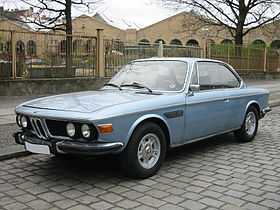BMW E9
| BMW E9 | |
|---|---|

BMW 3.0 CS
|
|
| Overview | |
| Manufacturer | BMW (coachbuilt by Karmann) |
| Also called | New Six Coupé |
| Production | 1968-1975 |
| Body and chassis | |
| Class | Grand tourer |
| Layout | FR layout |
| Body style(s) | Coupé |
| Vehicles | 2800 CS 3.0 CS 3.0 CSi 3.0 CSL 2.5 CS |
| Related | 2000 C, 2000 CS, E3 sedans |
| Powertrain | |
| Engine(s) |
M30 straight-6 engines: 2.5 L twin carb (2.5 CS) 2.8 L twin carb (2800 CS) 3.0 L twin carb (3.0 CS) 3.0 L fuel injection (3.0 CSi, 1971-1973 3.0 CSL) 3.2 L fuel injection (1973-1975 3.0 CSL) |
| Transmission(s) | 4 speed manual 3 speed automatic |
| Dimensions | |
| Wheelbase | 2,624 mm (103 in) |
| Length | 4,660 mm (183 in) |
| Width | 1,670 mm (66 in) |
| Height | 1,370 mm (54 in) |
| Curb weight | 1,420 kg (3,131 lb) |
| Chronology | |
| Predecessor | BMW 2000C, BMW 2000CS |
| Successor | BMW E24 (BMW 6-Series) |
The BMW New Six CS (internal name BMW E9) is a two-door coupé built for BMW by Karmann from 1968 to 1975. It was developed from the New Class-based BMW 2000 CS coupé, which was enlarged to hold the BMW M30 straight-6 engine used in the E3 sedan.
The E9 platform, especially the 3.0 CSL homologation special, was very successful in racing, especially in European Touring Car Championship and the Deutsche Rennsport Meisterschaft. This helped to establish BMW's status as a sporty driver's car.
The BMW 2000C and 2000 CS were introduced In 1965. Based on the New Class, the 2000 C and CS were Karmann-built coupés featuring the then-new two litre version of the M10 engine. The 2000 C had a single carburettor engine that produced 100 horsepower (75 kW), and was available with either manual or automatic transmission, while the 2000 CS had a two carburettor engine that produced 120 horsepower (89 kW) and was available only with a manual transmission.
The first of the E9 coupés, the 2800 CS, replaced the 2000 C and 2000 CS in 1968. The wheelbase and length were increased to allow the engine bay to be long enough to accommodate the new straight-six engine code-named M30, and the front of the car was restyled to resemble the E3 sedan. The rear axle, however, remained the same as that used in the lesser "Neue Klasse" models and the rear brakes were initially drums - meaning that the 2800 saloon was a better performing car, as it was also lighter. The CS' advantages were thus strictly optical to begin with. The 2800 CS used the 2,788 cc (170.1 cu in) version of the engine used in the E3 sedans. The engine produced 170 horsepower (130 kW) at 6000 revolutions per minute.
Not only was the 2800 CS lighter than the preceding 2000 CS, it also had a smaller frontal aspect, further increasing the performance advantage.
...
Wikipedia
